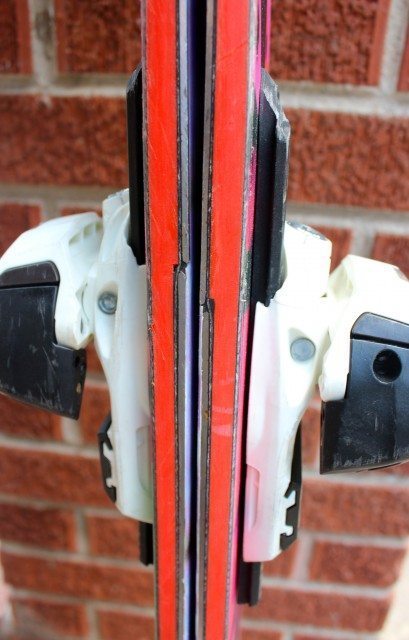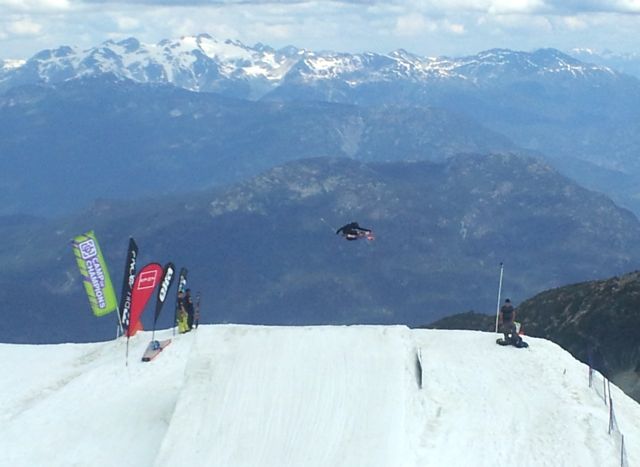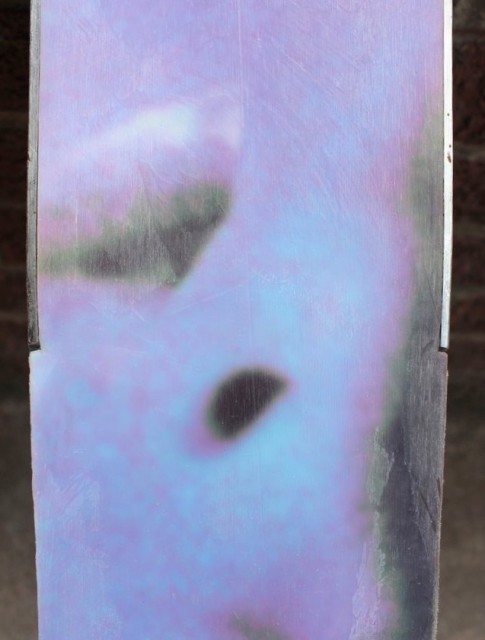
Ski: 2013-2014 MOMENT Frankenski, 178cm
Dimensions (mm): 114-92-114
Actual Tip-To-Tail Length (Straight Tape Pull): 175.25 cm
Sidecut Radius: 21 meters
Effective Edge (mm): 1460
Days tested: 6
Test Location: Camp of Champions (Whistler-Blackcomb, BC)
Anyone who hits a lot of park rails is familiar with blown-out edges. Traditional ski edges don’t stand a chance against the harsh abuse that the typical park skier doles out, and park ski manufacturers have tried some very peculiar designs to combat this problem.
A few years ago, Armada started selling the Tanner Hall pro model skis with a factory-rounded edge. Elan and Dynastar both incorporated a second edge underfoot about a centimeter in from the primary edge. Ninthward will use “replaceable edge technology” in their 2013-2014 lineup, and ON3P has started putting 2.5mm thick edges on their skis.
Moment’s Frankenski is one of the latest attempts to prevent blown-out edges. And I think it could prove to be the most ingenious and practical solution yet—even though this particular ski might benefit from a few tweaks.
Testing
I tested the Frankenski at the Camp of Champions’ park on the Horstman Glacier at the top of Blackcomb. At this park, a summer skiing facility with jumps up to 70-feet long and plenty of big rails, I was able to test the Frankenski on a broad range of large, high-impact features.
The Franken-Edge
While my experience with the Frankenski isn’t limited to its unique edge, I’m going to make that technology and its on-snow performance the focal point of this review since it’s so different from everything else on the market.
The Frankenski has a 15-inch segment of edge underfoot that’s separate from the standard edge material along the rest of the ski. This section is raised vertically up into the sidewall of the ski (toward the topsheet), so it’s no longer on the same plane as the “normal” edge material that runs to the tip and tail.
In order to maintain a smooth edging surface, the empty space created by the sunken Franken-Edge is filled with base material. Or rather, the ski’s base material continues outward, overlapping the offset edge.
This way, the damage-resistant base material, rather than the true edge, takes the brunt of the impact when you’re connecting with rails and boxes. The Franken-Edge is long enough (15 inches) that it’s going to take the majority of these rail impacts, unless you slide almost every rail you hit in an ultra-aggressive nose or tail press—pretty unlikely.

Profile / Flex
The Frankenski has rocker in the tip and tail, mild traditional camber underfoot, and a section of “micro-camber” (roughly 10cm long), in front of the toe piece and behind the heelpiece. Moment claims this “Dirty Mustache Rocker” profile “lets the ski surf and slash in powder, while the micro-camber sections create focused edge pressure on hardpack for carving.”
The Frankenski has an incredibly soft tip and tail—a flex pattern that’s mostly contained in its rockered sections. Hand flexing the ski reveals hinge-points focused around the sections of micro-camber where the ski gets noticeably stiffer.
The flex is stiffer throughout the section of traditional camber underfoot, but I still wouldn’t call it very stiff. In this middle section, the ski’s flex is similar to that of the Scott Jib TW. Both skis are fairly soft.
The Frankenski has a bamboo core, which aims to combine dampness and responsiveness. Since I usually prefer stiffer skis, I was curious to test how the dampness of a bamboo core would benefit an otherwise soft ski.

Franken-Edge: Rail Performance
Before testing the Frankenski, I didn’t know whether I needed to round off the “edge” underfoot with a bastard file or a gummy stone as I would with a traditional park ski. I decided I wouldn’t mess with the ski in order to give the Franken-Edge a fair shot, and I’m happy with my decision.
I was immediately impressed by how smooth the base material underfoot slid on rails. I never got hooked up on a rail or felt like the right angle of the edge slowed me down. I’d definitely expect to get caught up on a rail / box on a traditional park ski without detuning extensively.
While I never got the chance to test the Franken-Edge on sliding surfaces such as wood or corrugated pipes, its consistency and predictability on rails makes me think that it will handle many jib-able materials well.
Before riding the ski, I was worried about the points where the Franken-Edge meets the ski’s traditional edge. The base material is much softer than the edge it covers, so I expected the two materials to wear at different rates and thus create a spot that would hang me up—particularly when sliding into and out of nose and tail presses. After six days of riding, I have yet to find evidence that this will happen, but I can’t say for certain that it won’t be an issue at the end of a season.

Durability
While uneven wear wasn’t an issue at the connection points, I did find that the base material underfoot wore out fairly quickly. Strands of this material—up to an inch long and a millimeter thick—would peel off at the edge, particularly after hard impacts or edge-sets on rails (for switch-ups and spin offs). Toward the end of the testing period, I began to slide on the actual edge below the base material in a few very small areas (no wider than two or three millimeters).
This quick wear of the underfoot base material is concerning since I only tested the skis for six days. But I’m still optimistic about this design because the base material continued to absorb the brunt of rail impacts and sliding abuse, taking much of the stress off the edge.
Do I think the Franken-Edge is invincible? No. I think that if I were to ski the Frankenski for a whole season, there’s some chance I’d still blow out an edge. But I will say that I think this new technology will delay that day much longer than if I was riding a traditional park ski.

they did this kind of thing with the burton dominant slick a while ago it was good when the board was newish but as the base and edges get beat up the joint between the base material and regular edge would start to hook up as the gap slowly got wider and on the burton board the way that the base material met it actually would hook up unexpectedly and make for a really sketchy ride.
Lance, that was my concern as well. After the six day review period, I did experience some fraying and wear. After a full season, experiencing the same issues that you noted is definitely a possibility.
NIce review man but you’ve obviously never skied the death wish. The camber is all about being surfy.